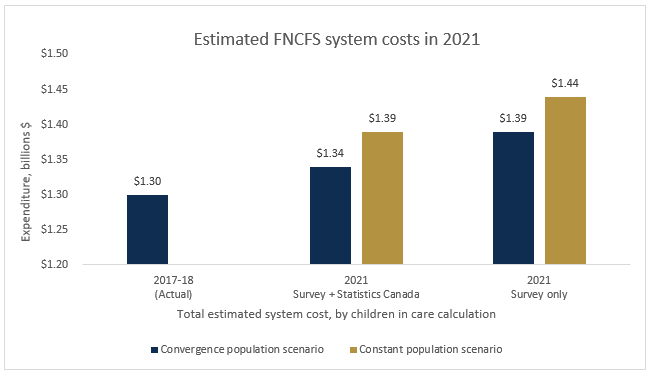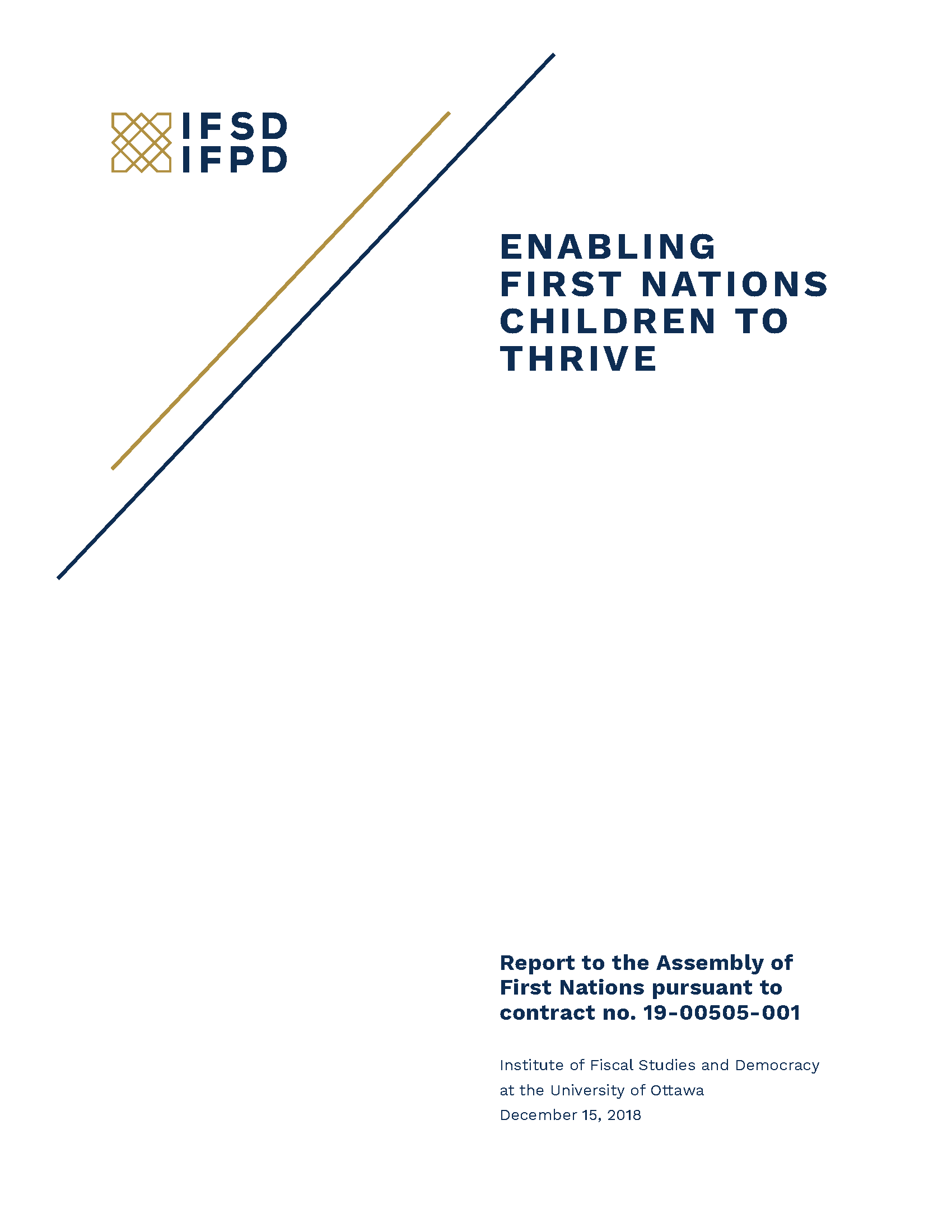A First Nations Child and Family Services Agency (FNCFS)
FNCFS Project - Phase 1
First Nations Child and Family Services (FNCFS) - Final Report
Author:
Dr. Helaina Gaspard, Director, Governance and Institutions
helaina.gaspard@ifsd.ca
Previous Monthly Updates
January 2019
EXECUTIVE SUMMARY
In January 2016, the Canadian Human Rights Tribunal (CHRT) ruled that First Nations children were being discriminated against in the child welfare system. Overrepresented in a system that incentivized the placement of children in care, First Nations children and agencies were deemed to be underfunded relative to their needs. Through subsequent orders in 2018, the CHRT ordered analysis of the complete costs of the First Nations child welfare system based on the needs of First Nations agencies. Canada states that it is committed to implementing these orders.
As the complainants in the case, the Assembly of First Nations (AFN) and the First Nations Child and Family Caring Society of Canada requested that the Institute of Fiscal Studies and Democracy (IFSD) at the University of Ottawa produce a response to CHRT (2018) orders 408, 418, and 421. IFSD engaged with AFN as the project contract holder and with the National Advisory Committee on First Nations Child and Family Services (NAC) for directional and strategic support. Pursuant to the orders, IFSD was asked to:
- Develop reliable data collection, analysis and reporting methodology for analyzing the needs of First Nations Child and Family Services (FNCFS) agencies, in alignment with the Canadian Human Rights Tribunal (CHRT) rulings on discrimination against First Nations children in care (CIC).
- Provide technical expertise to analyze agency needs, provide strategic advice on how best to monitor and respond to actual age ncy needs from fiscal and governance perspectives, with an approach informed by understanding, existing research, the contractor’s own research and analysis of assessments done by agencies and communities.
- Analyze the needs assessments completed by agencie s and communities, create a baseline definition of agency resource inputs and outputs and identify missing data, complete a cost analysis and prepare a final report.
1 The National Advisory Committee (NAC) is a committee established after the publication of the First Nations Child and Family Services Joint National Policy Review Final Report in 2000 in order to fulfill the recommendations made by the report. The committee consisted of Aboriginal Affairs and Northern Development Canada (AANDC) employees (what today has been divided into Indigenous Services Canada and Crown Indigenous Affairs), FNCFS staff and AFN representatives. After the CHRT decision in January 2016, the NAC was reconvened to monitor the reform of the FNFCS program. NAC’s current terms of reference are available here: https://www.afn.ca/wp-content/uploads/2017/05/NAC-Final-Terms-of-Reference.pdf The current NAC is comprised of representatives from the federal government, representatives from the AFN, representatives from the First Nations Child and Family Caring society, regional representatives (generally from a FNCFS agency), a youth representatives and an elder representative. NAC is functionally managed by AFN (i.e. it convenes the meetings and can enter into contracts on behalf of NAC). In the context of this project, NAC served as a board of directors offering perspective and strategic advice (without interfering in the research, analysis and delivery of the project).
Analysis and Findings
- IFSD reviewed existing needs assessments completed by agencies and communities. IFSD’s analysis concluded that this information was not collected and completed in a systematic manner and would not support the development of costing and performance assessment.
- IFSD undertook its work, regarding understanding agency needs, through primary data collection from May 2018 to June 2018, with consultations with agency directors and experts throughout the project. The data collection instrument was a 105-question survey covering agency details to finances to employees to caseloads. IFSD is privileged to have learned from a representative 76% of FNCFS agencies.
- Key observations and findings from the IFSD – Agency survey include:
- Agency characteristics transcend provincial boundaries and funding formulas. An agency serving remote communities in Ontario shares characteristics similar to those serving remote communities in British Columbia.
- Budgets, while most agencies do not run deficits, they emphasized need for investment in capital and people. Agency budgets are most tightly correlated with children in care (unsurprising, given the structure of the current system).
- Employees: Most agencies (62%) cannot remunerate their employees at provincial salary levels. Agencies noted the regular over-extension of staff beyond their defined duties.
- Capital and information technology (IT): Nearly 60% of agencies indicated a need for capital repair and investment. Agency IT funded on average at 1.6%, is severely underfunded when compared to the industry standard of approximately 5-6%.
- Governance and Data Capacity: While some agencies use internal data to improve their planning, programming and decision-making, significant data gaps exist in aligning inputs and outputs to better understand short-, medium-, and long-term outcomes for children and families that interact with the FNCFS system.
- The most significant cost driver of the current system is the number of children in care, which correlates tightly to agency total budgets.
- Costing models, based on the average cost of a child in care, suggest that under a no-policy change assumption, inflation and population alone would drive a total system cost increase of between $40 million to $140 million by 2021, depending on population scenario assumptions used, from $1.3 billion in 2017-18.

- IFSD undertook benchmark analysis to highlight specific gaps related to spending on prevention, capital and IT. These spending gaps would be in add ition to baseline adjustments highlighted above for inflation and population which would ensure budgets are appropriately adjusted for demand and price going forward.
- Prevention: funded per capita across the total population served, from $800-$2,500 per person, prevention program costs estimates for 2019 range from $224 million to $708 million. These costs would be on-going in nature and subject to changes in population and inflation.
- Capital: a one-time capital investment of $116 million to $175 million, with a recommended further budgeting of 2% annual recapitalization rate, for a facility equivalent to the agency’s headquarters.
- IT: annual expenditure of 5-6% of total budget, pursuant to industry standards, with a cost in the range of $65 million to $78 million per annum.
- First Nations communities face systemic issues which add significant case complexity for child welfare workers. These issues include intergenerational trauma related to residential schools, higher incidences of inadequate housing, subst ance misuse, poverty, among others. Until these issues are addressed through an array of prevention type programs, incidences of child protection for First Nations peoples will remain above those of non-First Nations. There is a cost to closing these gaps.
- Median household incomes in 44% of First Nations communities served by FNCFS agencies fall below their provincial poverty line. Raising those households only to their respective provincial poverty line would require annual expenditure of $205 million. For comparison purposes, raising the same households to median household incomes of their provinces would require annual expenditure of about $2.6 billion.
- Agency workers and independent experts consulted have started to map a new system to support children, families and communities. Moving beyond a narrow focus on protection of children, to a vision of enabling children to thrive, the proposed approach would align results (outcomes) to activities (outputs) and required resources (inputs) across safety, child well-being, family well-being and community well-being. This vision is focused on changing outcomes for children by empowering agencies, communities and families, and understanding progress through relevant and regular data collection on indicators connected to desired results (see table 1 below).
Recommendations
The current protection-focused system does not produce adequate results for children and families, fails to recognize the contextual challenges that lead to disadvantaged starting points for many communities, significantly underfunds prevention, has important gaps in capital and IT spending, struggles to remunerate employees relative to provincial levels, and falls short on data collection and analytics required to identify and support wise practices.
In this context, IFSD makes a number of recommendations:
- It is recommended that block transfers be used to fund the FNCFS program to provide flexibility in allocation and accountability to stakeholders.
- It is recommended that contextual issues such as poverty, be recognized and addressed through policy, programs and funding.
- It is recommended that prevention be funded on a per capita basis for the total population served by the agency (not only children) at a rate of $800-$2,500 per person.
- It is recommended that beyond the one-time capital investment, that a benchmark recapitalization rate of a minimum 2% per annum (of asset base) be added to the agency budgets.
- It is recommended that IT be funded at a rate of 5%-6% of total annual budget, consistent with industry practices.
- It is recommended that:
- Social workers be remunerated at provincial salaries levels.
- A study be undertaken to assess why FNCFS agencies are unable to remunerate their employees at provincial levels.
- A study on case complexity be undertaken, with consideration of differing community contexts when determining reasonable caseload levels.
- FNCFS employees have access to professional support and development, including leave for compassionate fatigue.
- It is recommended that a secretariat dedicated to results-oriented data be established to support FNCFS agencies in their work.
- It is recommended that a FNCFS resource centre be established as a platform for knowledge sharing and collaboration among FNCFS agencies in support of their common mandates.
Recommendations for Further Research
IFSD has three recommendations with respect to next-steps to further the work undertaken in this study:
- To establish a performance framework to underpin the First Nations Child and Family Services system across Canada
- To develop a range of options with regards to the funding models that would support an enhanced performance framework; and,
- To transition to a future state in full consideration of data, human capital and governance requirements.
A Note of Thanks
IFSD wishes to thank the members of NAC for their on-going feedback and support of this work. We are grateful for the support of Dr. Cindy Blackstock and the Caring Society, Jonathan Thompson, Martin Orr and AFN.
We thank Thomas Anderson of Statistics Canada’s Social and Aboriginal Statistics for clarifying availability and applicability of data. We thank our expert reviewers, especially Professors Scott Bennett and John Loxley for their helpful comments in the research and analysis processes, as well as our expert roundtable composed of nationally recognized academic experts in social work, Indigenous health, evaluation, and substance misuse, as well as practitioners and agency leaders, whose knowledge was invaluable in framing performance considerations.
We thank the leadership and staff of FNCFS agencies for the incredible work that they do in saving lives of children under the most difficult and disadvantaged environments imaginable. The strong survey response rate and robustness of results was entirely dependent on the trust, participation, and support of FNCFS agencies and their leadership. IFSD is grateful for their confidence and for the knowledge and insight they shared.
| PERFORMANCE ATTRIBUTES | DESCRIPTION | CURRENT STATE (2018) | FUTURE STATE | ||
|---|---|---|---|---|---|
| Protection | Protection | Prevention | Poverty | ||
| INPUT |
|
|
|
|
|
| OUTPUT |
|
|
|
|
|
| OUTCOMES |
|
|
| ||
Table 1: Future state vision for FNCFS agencies.




